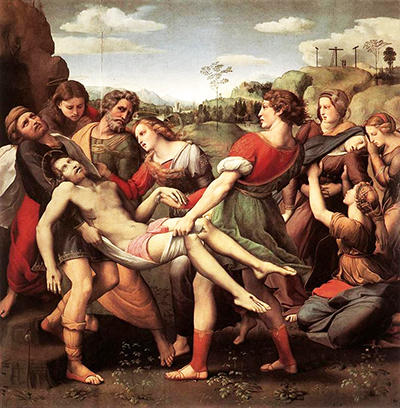The Deposition is a popular Italian Renaissance painting by Raphael depicting the Deposition, the Lamentation of Christ, and entombment of Christ.
This painting is also known as the Pala Baglione, The Entombment, or the Borghese Deposition and it currently resides in Galleria Borghese, Rome. This masterpiece dates back to the 16th century when violence arose in Italy among gangs. On 3rd July 1500, Grifonetto Baglioni an Italian was murdered in one of the common gang-related incidents. In his memory, the mother commissioned Raphael to create a piece in his remembrance, and that is how The Deposition came about. The altarpiece is on a wooden panel which measures approximately 184 cm x 176 cm.
The Deposition altarpiece comprised of more than the main panel. It had a top moulding which had a panel depicting God the Father in the glory of a cherub blessing his only son. The central panel had a frame adorned with griffins being fed and crowned by putti with wings seated on the heads of rams, all in a yellow-bronze colour and a blue ground. Below it was predella that consisted of three compartments showing the Theological Virtues.
Originally, the three panels were lined up at the bottom of the painting to illustrate, right to left, Faith, Charity and Hope, with each figure lined by two putti. Again the predellas subjects are symbolically meant to relate to the main panel: Charity is placed in the centre to emphasise the subject of motherhood, while Faith and Hope refer to the redemption of Christ which is the principle motif. Thus the conception of Raphael does not only refer to the theme of the painting, but also to the personal circumstances of Atalanta Baglioni, the donor.
Raphael made many preliminary drafts or sketches as his idea for the painting evolved. He began with the subject of Lamentation over the slain Christ, almost similar to the popular painting bearing the same name created by Pietro Perugino, one of his teachers. He later moved from that subject to the Entombment of Christ, probably influenced by Michelangelo's Entombment, an ancient Roman from Greek mythology, or Mantegna's famous print of the Entombment. Looking through Raphael's studies and work, we can see that the long duration of evolution gave him the opportunity to practice more of the new techniques and styles he had been creating from his studies of Michelangelo and Leonardo da Vinci as well as other popular artists of that time. The two design stages can be broadly be labelled Florentine and Perugian. The great change of idea from Lamentation to Entombment significantly affected the character of the altarpiece on the whole since it changed from a symbolic Pieta to an idea with more narrative interests.
The Deposition masterpiece is typically considered a narrative painting because it tells of the final days of Christ. Most people see the Lamentation and the Entombment of Christ as pretty instrumental pieces of art, and most viewers are greatly moved by the sad scenes. One of the youths seen carrying the body of Jesus depicts Grifonetto Baglioni, whom the piece is dedicated to. Mary Magdalene and St. John can be seen in the artwork walking alongside the body, and also Virgin Mary in another group of people being supported after appearing to have fainted due to the grief.




